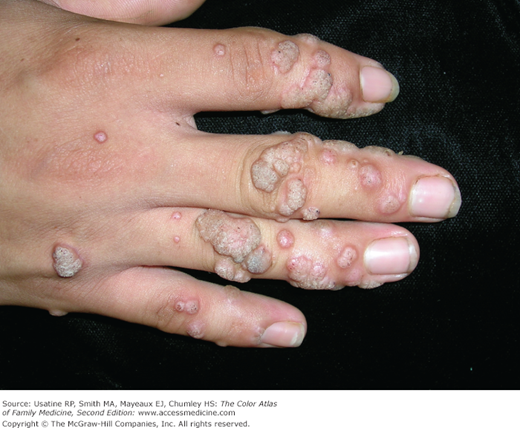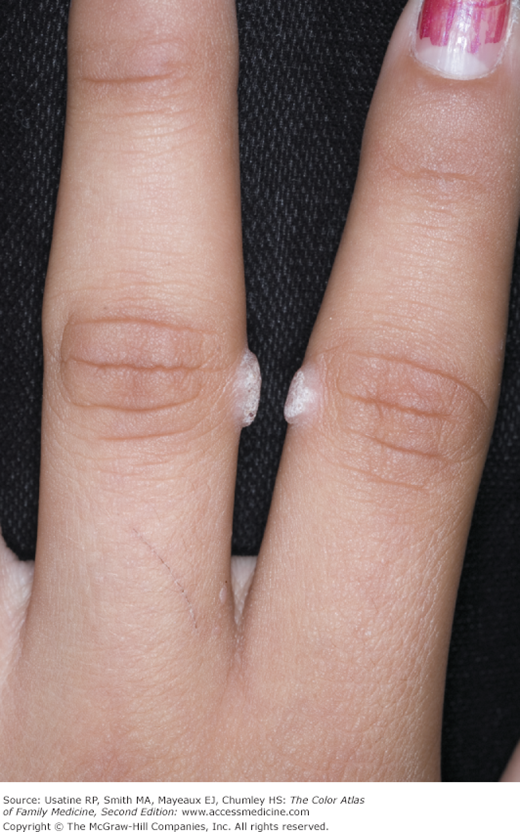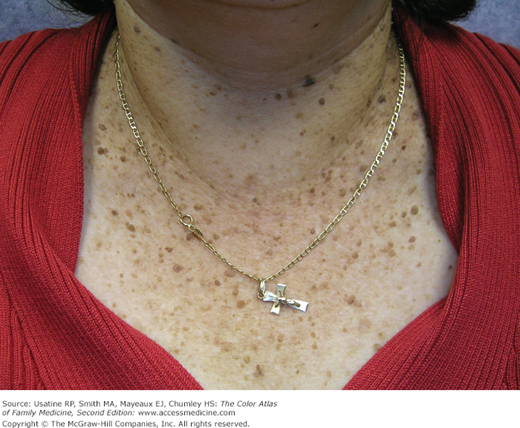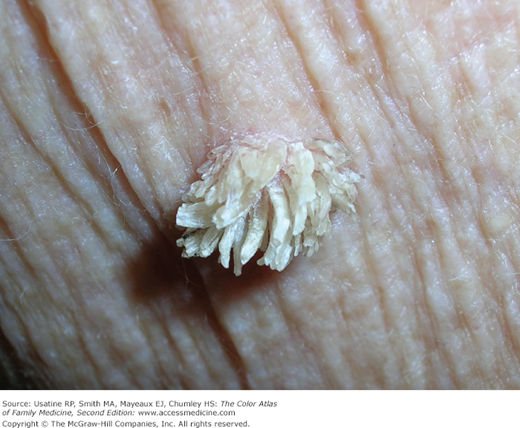Patient Story
An 11-year-old girl presents with warts on her fingers that have not responded to nonprescription wart medications (Figure 131-1). It causes her and her mother some social embarrassment and they would like to be rid of them. Her mother is also worried that it is affecting her daughter’s nails. The girl was able to tolerate the discomfort of liquid nitrogen treatment and wanted all her warts treated. The mother was instructed to purchase 40% salicylic acid to continue treatment of any residual warts at home.
Introduction
Human papillomaviruses (HPVs) are DNA viruses that infect skin and mucous membranes. Infection is usually confined to the epidermis and does not result in disseminated systemic infection. The most common clinical manifestation of these viruses is warts (verrucae). There are more than 100 distinct HPV subtypes based on DNA testing. Some tend to infect specific body sites or types of epithelium. Some HPV types have a potential to cause malignant change but transformation is rare on keratinized skin.
Epidemiology
- Nongenital cutaneous warts are widespread worldwide and are more common in children, with a peak incidence in the teenage years and a sharp decline thereafter.1
- They are most commonly caused by HPV types 1 to 5, 7, 27, 29.1
- Common warts account for approximately 70% of nongenital cutaneous warts.2
- Common warts occur most commonly in children and young adults (Figures 131-1 and 131-2).3
Etiology and Pathophysiology
- Infection with HPV occurs by skin-to-skin contact. It starts with a break in the integrity of the epithelium caused by maceration or trauma that allows the virus to infect the basal layers.
- Warts may infect the skin on opposing digits causing “kissing warts” (Figure 131-3).
- Individuals with subclinical infection may serve as a reservoir for HPVs.
- An incubation period following inoculation lasts for approximately 2 to 6 months.
Risk Factors
- Young age.
- Disruption to the normal epithelial barrier.
- More common among meat handlers.
- Atopic dermatitis.
- Nail biters more commonly have multiple periungual warts.
- Conditions that decrease cell-mediated immunity such as HIV (Figure 131-4) and immunosuppressant drugs (Figure 131-5).
Figure 131-5
Biopsy-proven warts on the neck and chest of a woman on azathioprine after a renal transplantation. Human papillomaviruses lesions can proliferate as a result of immunosuppressive medications. This patient is also being monitored for squamous cell carcinoma, as this is a more significant risk in posttransplantation patients. (Courtesy of Richard P. Usatine, MD.)
Diagnosis
- The diagnosis of warts is based upon clinical appearance. The wart will obscure normal skin markings.
- Common warts are well-demarcated, rough, hard papules with irregular papillary surface. They are usually asymptomatic unless located on a pressure point.
- Warts may form cylindrical of filiform projections (Figure 131-6).
Figure 131-6
Filiform warts are identified by their multiple projections as opposed to a unified papule. This wart was on the face of an elderly woman and was removed by shave excision and sent for pathology. It was proven to be a wart and not squamous cell carcinoma. (Courtesy of Richard P. Usatine, MD.)
- Common anatomic locations include the dorsum of the hand, between the fingers, flexor surfaces, and adjacent to the nails (periungual) (Figures 131-1 and 131-2).
- HPV testing is not useful for this condition.4
- HIV testing may be useful if the warts are severe and there are risk factors present (Figure 131-4).









